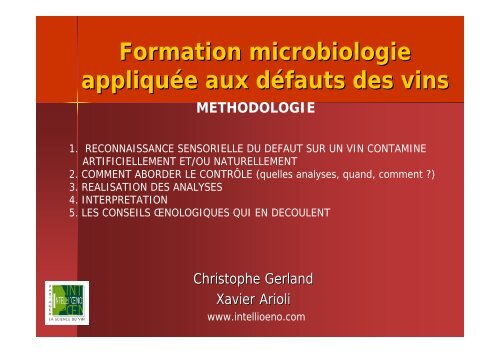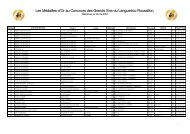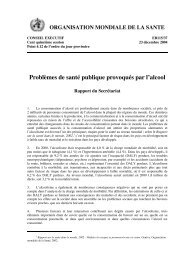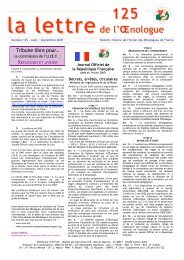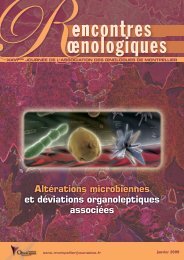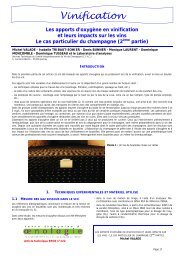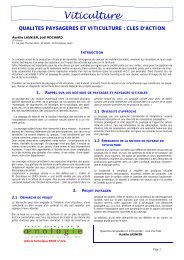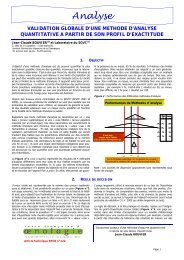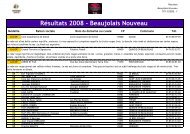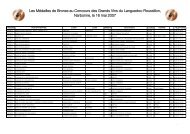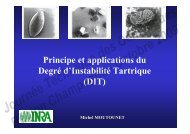Formation microbiologie appliquée aux défauts des vins - Union des ...
Formation microbiologie appliquée aux défauts des vins - Union des ...
Formation microbiologie appliquée aux défauts des vins - Union des ...
- No tags were found...
You also want an ePaper? Increase the reach of your titles
YUMPU automatically turns print PDFs into web optimized ePapers that Google loves.
<strong>Formation</strong> <strong>microbiologie</strong><strong>appliquée</strong> <strong>aux</strong> <strong>défauts</strong> <strong>des</strong> <strong>vins</strong>METHODOLOGIE1. RECONNAISSANCE SENSORIELLE DU DEFAUT SUR UN VIN CONTAMINEARTIFICIELLEMENT ET/OU NATURELLEMENT2. COMMENT ABORDER LE CONTRÔLE (quelles analyses, quand, comment ?)3. REALISATION DES ANALYSES4. INTERPRETATION5. LES CONSEILS ŒNOLOGIQUES QUI EN DECOULENTChristophe GerlandXavier Arioliwww.intellioeno.com
<strong>Formation</strong> <strong>microbiologie</strong><strong>appliquée</strong> <strong>aux</strong> <strong>défauts</strong> <strong>des</strong> <strong>vins</strong>DETAIL DU CONTENU1. PHENOLS VOLATILS (principalement liés à BRETTANOMYCES)1. RECONNAISSANCE A LA DEGUSTATION2. RECONNAISSANCE AU MICROSCOPE3. NUMERATIONS : COMPARAISON DE MILIEUX DE CULTURE4. NUMERATION EN CYTOMETRIE DE FLUX ET EN EPIFLUORESCENCE5. TESTS UTILISANT LA BIOLOGIE MOLECULAIRE (démonstration, comparaisontechnique et financière <strong>des</strong> métho<strong>des</strong> existantes)5. RESOLUTIONS DE 4 CAS PRATIQUES AVEC STRATEGIE A ADOPTERET ETUDES DE CES CAS : vin jeune sans fût, élevage long, mise en bouteille,contrôles de barriques.6. DISCUSSIONS SUR LES METHODES DE PREVENTION ET D’ELIMINATIONDES BRETT DU VIN ET DES FUTS
<strong>Formation</strong> <strong>microbiologie</strong><strong>appliquée</strong> <strong>aux</strong> <strong>défauts</strong> <strong>des</strong> <strong>vins</strong>DETAIL DU CONTENU2. DEVIATIONS LACTIQUES : PIQURE LACTIQUE, GRAISSE, GOUT DE SOURIS,MALADIE DE L’AMERTUME• RECONNAISSANCE A LA DEGUSTATION• OBSERVATION DES BACTERIES IMPLIQUEES AU MICROSCOPE• NUMERATIONS SUR MILIEUX DE CULTURE• NUMERATION EN EPIFLUORESCENCE• CONFIRMATIONS PAR TECHNIQUES CLASSIQUES• CONFIRMATIONS PAR LA BIOLOGIE MOLECULAIRE• RESOLUTIONS DE 4 CAS PRATIQUES• DISCUSSIONS SUR LES METHODES DE PREVENTION ET D’ELIMINATION
<strong>Formation</strong> <strong>microbiologie</strong><strong>appliquée</strong> <strong>aux</strong> <strong>défauts</strong> <strong>des</strong> <strong>vins</strong>DETAIL DU CONTENU3. GOUTS D’ACETATE (liés <strong>aux</strong> Schizo ou <strong>aux</strong> Kloeckera)• RECONNAISSANCE A LA DEGUSTATION• OBSERVATION DES GERMES IMPLIQUES AU MICROSCOPE• NUMERATIONS SUR MILIEUX DE CULTURE• NUMERATION EN EPIFLUORESCENCE• CONFIRMATIONS PAR TECHNIQUES CLASSIQUES• CONFIRMATIONS PAR LA BIOLOGIE MOLECULAIRE• RESOLUTIONS DE 2 CAS PRATIQUES• DISCUSSIONS SUR LES METHODES DE PREVENTION ET D’ELIMINATION
<strong>Formation</strong> <strong>microbiologie</strong><strong>appliquée</strong> <strong>aux</strong> <strong>défauts</strong> <strong>des</strong> <strong>vins</strong>DETAIL DU CONTENU4. REDUCTIONS ET OXYDATIONS D’ORIGINE MICROBIOLOGIQUE• RECONNAISSANCE A LA DEGUSTATION• OBSERVATION DES GERMES IMPLIQUES AU MICROSCOPE• APPROCHE ANALYTIQUE GLOBALE• RESOLUTIONS DE 4 CAS PRATIQUES• DISCUSSIONS SUR LES METHODES DE PREVENTION
<strong>Formation</strong> <strong>microbiologie</strong><strong>appliquée</strong> <strong>aux</strong> <strong>défauts</strong> <strong>des</strong> <strong>vins</strong>DETAIL DU CONTENU5. ANALYSES DE TROUBLES ET DEPOTS EN BOUTEILLES• METHODOLOGIE• RESOLUTIONS DE 4 CAS PRATIQUES SOUS FORME D’EXERCICE• DISCUSSIONS SUR LES METHODES DE PREVENTION ET D’ELIMINATION6. GERMES DE CONTAMINATION DES RAISINS (goûts terreux, ochratoxine,goûts de champignon)LES TECHNIQUES MICROBIOLOGIUES EXISTANTESEXEMPLES D’UTILISATIONETUDE DE 3 CAS


